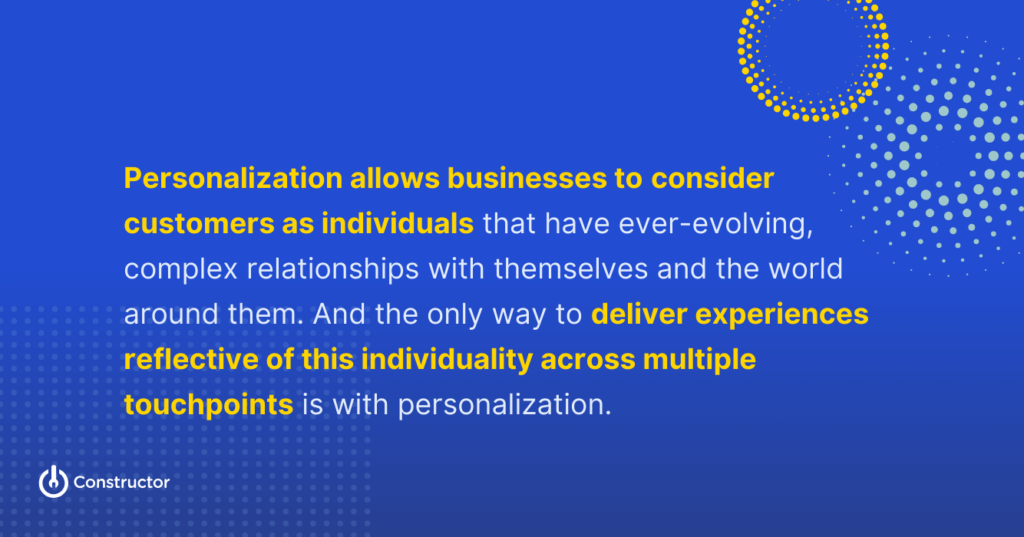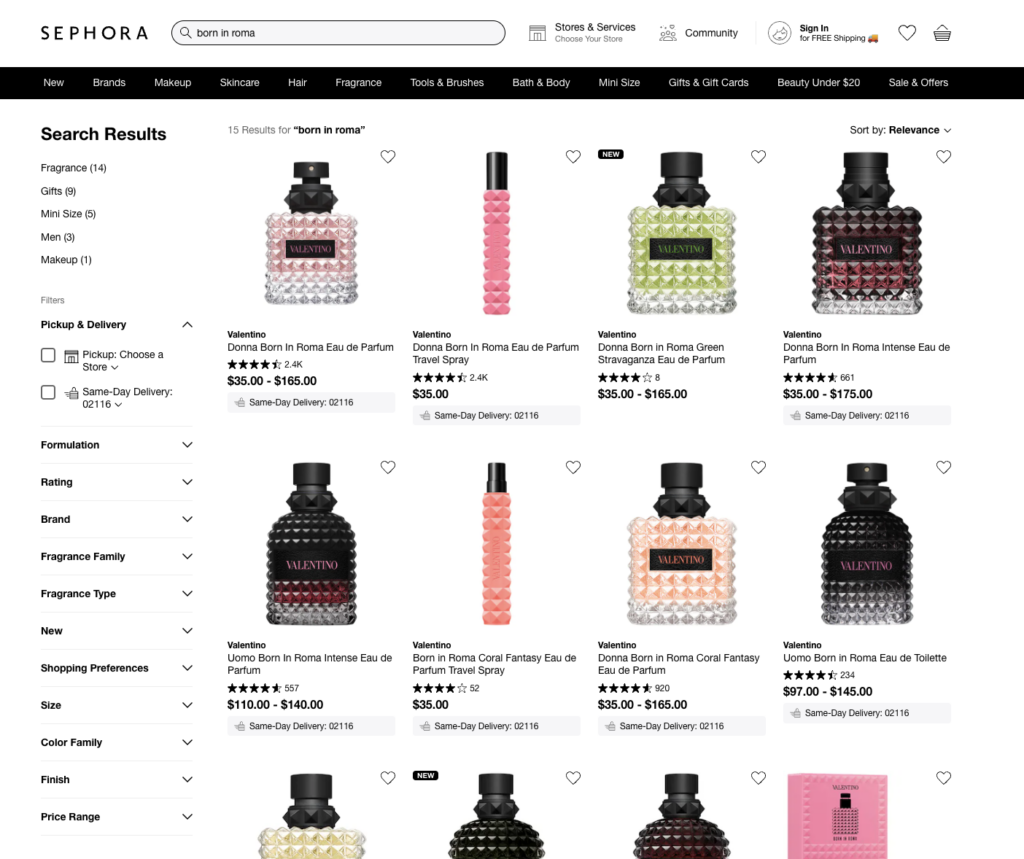All brick-and-mortar shoppers want to feel understood. As consumers, we chase the feeling of when our barista remembers our coffee order and first name. We feel seen and valued in the recognition, and this makes us more likely to frequent that coffee shop. In ecommerce, it’s no different.
Providing tailored product recommendations and a personalized experience is about tending to that business-to-human relationship, which is essential for capturing and converting attention in today’s highly competitive ecommerce landscape filled with an abundance of choices.
Fortunately, advancements in technology have made it easier than ever for ecommerce businesses to satisfy consumer’s ever-changing expectations.
Table of Contents
The Need for Personalization in Product Discovery
The Crux of Personalization in Product Discovery
- Dynamic re-ranking and personalization aren’t concurrent
- Configuring personalization is highly technical
- Legacy engines are based on decades-old software
The Need for Personalization in Product Discovery
Consumers think about brands much differently than how brands currently think about individual customers. A brand is a singular “thing” with its own unique attributes. A consumer may see their advertisements, read their emails, and like their social media posts, but each of those actions connect back to the brand itself.
But how much do emails, advertisements, social media posts, on-site experiences, etc. connect back to consumers as individuals?
Personalization allows businesses to consider consumers as individuals that have ever-evolving, complex relationships with themselves and the world. And the only way to deliver experiences reflective of this individuality across multiple touchpoints is with personalization.

The overarching goal of personalization is to boost critical business KPIs while also turning siloed conversations into one overarching conversation. As such, customers’ on-site behaviors and preferences should be reflected across all channels — including email, social media, ads, and more — for a truly omnichannel experience.
Again, throughout the ecommerce product discovery experience, it’s about making customers feel understood and seen. When executed well, this intentional focus on the customer heightens their satisfaction while driving your sales and allowing you to maintain a competitive edge.
Where Generative AI fits in
There’s a lot of buzz around Generative AI (GenAI) and its impact on ecommerce product discovery. Its advanced capabilities to analyze big data at scale and better understand customer preferences to create even more personalized experiences have most retailers drooling at the prospect. But it can also be difficult to make sense of what claims are simply marketing tactics or the real deal.
So what does the game-changing “real deal” look like? It’s ecommerce technology with an AI-native core that blends GenAI with user-level personalization to optimize for key metrics. This could take the shape of an AI Shopping Assistant, which suggests products to customers based on natural language queries, or back-end product discovery tools — like Attribute Enrichment and Dynamic Collections — that facilitate merchandisers’ work.
By strategically implementing GenAI-native technologies, shoppers stay on-site to research and shop, providing them with an easier, quicker product discovery experience. This increased website “stickiness” improves brand loyalty, conversions, and engagement. It’s a collective win.
The Crux of Personalization in Product Discovery: How Many Legacy Engines Are Configured
The majority of legacy search engines aren’t purpose-built with niche-specific (read: ecommerce) personalization in mind, leading to a subpar product discovery experience out of the box.
Let’s take a quick look at some of their common pitfalls.
Dynamic re-ranking and personalization aren’t concurrent
Re-ranking and personalization work best when they’re concurrent processes — e.g., both happen simultaneously. Search engines should dynamically re-rank products based on user behavioral data. They’re meant to complement each other to enhance the overall effectiveness of site-wide product recommendations.
Some product discovery engines aren’t configured to offer both concurrently. They’re akin to layered cakes, where you have to pass from one level to the next. For product discovery, that equates to starting with dynamic re-ranking, only to be followed by user-level personalization. This clunky process makes merchandisers’ jobs that much more challenging, as they have to work around these rules to rank products how they best see fit.
Solutions like Constructor function similarly to the human brain. Our AI-native product search and discovery engine is composed of separate components that work together to reach a common solution. Dynamic re-ranking and personalization are concurrent processes, working synergistically to surface attractive products — which improves user experience and conversion rates.
Configuring personalization is highly technical
Leveraging clickstream data is possible with other ecommerce product discovery engines, but the process isn’t smooth sailing. Merchandisers are left to figure out which events should influence personalization, how important each of those events are relative to each other, and how important each product attribute is in changing product results — all manually. (Had to read that twice through? So did we.)
Basically, it’s incredibly complicated to manually set weights — a.k.a. assign a value of importance to actions or product attributes. How can a merchandiser definitively know how much a click should matter versus a conversion, add-to-cart, or some other behavior?
Merchandisers’ plates are full already without having to play data scientist.
Forcing merchandisers to make an exponential number of decisions to optimize for a KPI and then manually configure it all overburdens them. The worst part is, having to tinker with all these moving parts means there’s no real guarantee their actions will lead to business success, especially since they can’t happen at scale.
Constructor’s Native Commerce Core™ automates personalization and product rankings based on KPIs you care about from the get-go. This native personalization improves the customer experience while reducing manual merchandising work. (And if deemed necessary by your ecommerce team, out-of-the-box personalizations can be tailored even further to business goals by working with our Data Science team.)
The Ultimate Guide to Searchandising with Constructor
In this comprehensive guide, learn exactly how our Search and Browse Capabilities, Merchant Intelligence, and Native Commerce Core empower merchandisers and product managers to consistently create personalized shopping experiences that don't just convert, but drive business KPIs.
Legacy engines are based on decades-old software
Older search engines are built on documentation search engines based on keyword matching. They don’t support ecommerce use cases.
Ecommerce businesses get the most ROI when their product discovery experience is powered by solutions purpose-built for ecommerce, rather than a one-size-fits-all solution.
What’s more, when businesses try to combine advanced AI solutions with older technology to improve a stale product discovery experience, they create an even bigger problem: Frankensearch.
Constructor’s Approach to Personalizing The Ecommerce Product Discovery Experience
Constructor’s Native Commerce Core™ is powered by advanced algorithms, transformers, and large language models (LLMs), using clickstream and behavior as critical signals to ensure results are attractive to users across their entire search and product discovery experience.
While behavioral data drives product rankings, we leverage a combination of core functionalities, algorithms, and models to rank and personalize product result sets. The main ones can be roughly divided into three categories:
- Item attractiveness. Informed by clickstream, these algorithms rank products in a way that’s attractive to the specific user.
- Group attractiveness. This is based on ranking products according to conversions garnered from collective clickstream data. It picks up on current trends and also leans on historically best-performing products.
- Base score. This score is calculated based on product popularity in the last 30 days across the whole site. In other words, how well did an individual product convert based on site-wide conversions? It’s then assigned a score.
These scores are all dynamically calculated to optimize for a KPI, and merchandisers are able to track all model scoring from their merchant tools dashboard. This provides transparency into how and why products are ranking certain ways across their ecommerce sites.

For a deep dive into Constructor’s core functionalities and logic behind how we rank products, even new products without clickstream data, click here.
Recent experimentations with transformers and LLMs
With the myriad of product search and discovery tools out there, it’s easy to assume they’re all created equal, offering the same benefits and level of flexibility when it comes to personalization. The real challenge for business leaders is in the decision-making: ensuring their investments are informed and strategic.
In recent years, Constructor has been experimenting with emerging technologies to further improve product rankings and user-level personalization. The first of these emerging technologies is transformers.
Transformers are advanced algorithmic models trained on large ecommerce data sets. They’re built on deep learning architecture with a natural language processing (NLP) model to weigh the importance of different words in a sequence.
Thanks to this deep understanding of a query in the context of clickstream, the use of transformers allows ecommerce companies to return more attractive and personalized results across their entire suite of product search and discovery tools — every interaction, every time. This provides a major boost to business KPIs like conversions, revenue, inventory balancing, and more.

We’re also experimenting with new LLMs in our products, which are a category of AI models that have been trained on massive amounts of text data to perform natural language understanding and generation tasks.
These models are also typically based on deep learning techniques, particularly transformer architectures. This allows them to mimic an understanding of the world from which the data comes, which has great implications for large ecommerce companies that send LLMs large amounts of domain-specific data.
We’ve been using them to improve filtering of irrelevant results for customers — as can be seen below when a consumer searches for “born in roma” on Sephora’s website.

After first ranking product results sets on our base models, those results pass through an LLM, which essentially acts as a “second-layer” model, to further refine and personalize products on a user-level.
And these experiments are happening in tandem with our innovations in GenAI (explained earlier), where tools like our AI Shopping Assistant improve product rankings specifically for ecommerce sites with large catalogs, delivering user-level personalization and an optimal product discovery experience for companies and users alike.
All in all, experimentation allows us to see where emerging technologies better fit into the product discovery puzzle, knowledge of which helps ecommerce companies provide a user-centric product discovery experience while staying competitive in an ever-changing marketplace.
Learn more about the future of AI in product discovery to ensure you’re making the right strategic investments for your ecommerce business.
The Future of Personalization
At the end of the day, it’s an AI world out there. And adapting to the times means fully understanding the technology that’s being offered and leveraging it to your advantage, especially when it comes to offering a distinguishable customer experience.
This is where personalization comes into play.
Personalization is more than just recommending products. It’s about delivering a seamless and tailored shopping experience that anticipates and meets the needs of each individual customer. By investing in personalization technologies and implementing strategies, you can differentiate your brand, increase customer loyalty, and drive long-term success in the competitive ecommerce landscape.
Check out our searchandising guide to how to consistently create personalized shopping experiences that don’t just convert, but drive business KPIs.
The Ultimate Guide to Searchandising with Constructor
Learn how ecommerce AI – not just any AI – improves KPIs and team efficiency.

